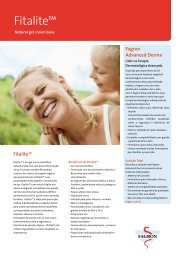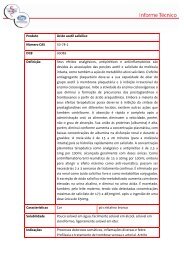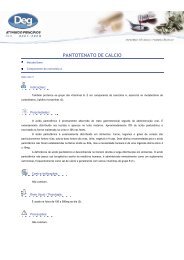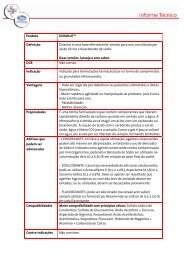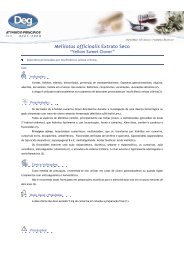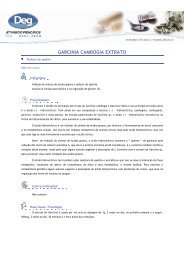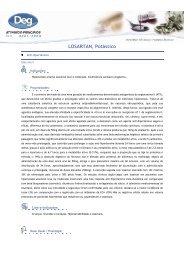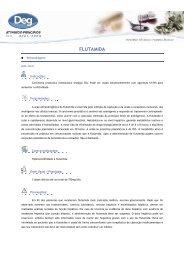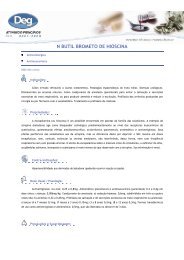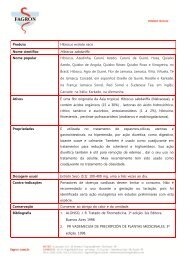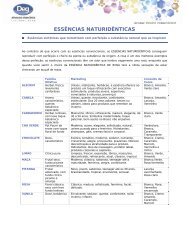Pulsatile administration of testosterone by the vaginal route ... - Fagron
Pulsatile administration of testosterone by the vaginal route ... - Fagron
Pulsatile administration of testosterone by the vaginal route ... - Fagron
You also want an ePaper? Increase the reach of your titles
YUMPU automatically turns print PDFs into web optimized ePapers that Google loves.
<strong>Pulsatile</strong> <strong>administration</strong> <strong>of</strong> <strong>testosterone</strong> <strong>by</strong><br />
<strong>the</strong> <strong>vaginal</strong> <strong>route</strong> using Pentravan ®<br />
H. Maia Jr. 1,2 , C. Haddad2 , R. Maia2 , C.E. França2 and J. Casoy2 1Department <strong>of</strong> Gynecology, Obstetrics and Human Reproduction, Federal<br />
University <strong>of</strong> Bahia, Salvador, Bahia, Brazil; 2Director <strong>of</strong> Research, Centro<br />
de Pesquisa e Assistência em Reprodução Humana (CEPARH), Salvador,<br />
Bahia, Brazil<br />
SUMMARY<br />
Testosterone defi ciency occurs during menopause and may be associated with <strong>the</strong><br />
appearance <strong>of</strong> a variety <strong>of</strong> symptoms in addition to its negative effect on sexuality. In<br />
<strong>the</strong> present study, <strong>testosterone</strong> was administered in <strong>the</strong> vulval/<strong>vaginal</strong> region at a dose<br />
<strong>of</strong> 3 mg/ml dissolved in a Pentravan ® emulsion (<strong>Fagron</strong>, <strong>the</strong> Ne<strong>the</strong>rlands) to patients<br />
with symptoms <strong>of</strong> androgen defi ciency and <strong>testosterone</strong> levels in <strong>the</strong> lower normal<br />
range. Vulval/<strong>vaginal</strong> application <strong>of</strong> <strong>testosterone</strong> in Pentravan ® increased blood levels<br />
<strong>of</strong> <strong>testosterone</strong> in a pulsatile manner from 20 ± 15 ng/dl (mean ± SD) (n=26) to<br />
312 ± 264 ng/dl (n=13) after 3 hours, followed <strong>by</strong> a rapid fall to 67 ± 40 ng/dl and<br />
26 ± 10 ng/dl 12 and 24 hours, respectively, after application. An improvement in<br />
sexuality and <strong>the</strong> sensation <strong>of</strong> well being was reported <strong>by</strong> 88% <strong>of</strong> <strong>the</strong> patients, with<br />
very few side effects. There was also a positive effect on <strong>vaginal</strong> atrophy.<br />
INTRODUCTION<br />
Testosterone plays an important role in women’s health during menopause, not<br />
only because it interacts with <strong>the</strong> androgen receptor, but also due to its transformation<br />
into estrogen through <strong>the</strong> action <strong>of</strong> aromatase whose expression in <strong>the</strong> tissues<br />
increases with age (1). Estrogen syn<strong>the</strong>sis in <strong>the</strong> tissues is pivotal for achieving<br />
optimal hormonal balance during menopause, since it occurs in all tissues except in<br />
<strong>the</strong> normal breast and endometrium. This process, however, is affected <strong>by</strong> <strong>the</strong> blood<br />
levels <strong>of</strong> sex hormone binding globulin (SHBG), <strong>by</strong> total <strong>testosterone</strong> level and ultimately<br />
<strong>by</strong> <strong>the</strong> amount <strong>of</strong> aromatase activity in <strong>the</strong> tissue (1). Presently, only total<br />
<strong>testosterone</strong> production, which diminishes with ageing, and SHBG levels can be<br />
manipulated in women in order to boost tissue estrogen production. Although <strong>the</strong>re<br />
© 2013 Monduzzi Editoriale | Proceedings Code: 891
17TH WORLD CONGRESS ON CONTROVERSIES IN OBSTETRICS,<br />
GYNECOLOGY & INFERTILITY (COGI)<br />
is a compensatory increase in aromatase tissue activity in women after 50 years <strong>of</strong><br />
age in response to rising interleukin-6 levels, this may not suffi ce to compensate for<br />
<strong>the</strong> declining production <strong>of</strong> <strong>testosterone</strong> or its precursors, thus resulting in <strong>the</strong> onset<br />
<strong>of</strong> symptoms <strong>of</strong> both androgen and estrogen deprivation (2). In addition to b eing an<br />
essential precursor to estrogen syn<strong>the</strong>sis, <strong>testosterone</strong> is also endowed with a potent<br />
antiinfl ammatory effect through <strong>the</strong> blockade <strong>of</strong> <strong>the</strong> NF-Kappa.b activation pathway<br />
(3). During ageing, <strong>the</strong>re is an increase in both subclinical chronic infl ammation<br />
and NF-Kappa.b activation, which may be <strong>the</strong> underlying cause <strong>of</strong> several diseases<br />
that affect elderly people such as a<strong>the</strong>rosclerosis, Alzheimer’s disease, osteoporosis,<br />
sarcopenia and depression as well as an increased risk <strong>of</strong> cancer (4-7). The mechanisms<br />
responsible for <strong>the</strong> increase in NF-Kappa.b activation with ageing are largely<br />
unknown; however, it may be one <strong>of</strong> <strong>the</strong> consequences <strong>of</strong> <strong>the</strong> reduction in <strong>testosterone</strong><br />
production, since this steroid hormone is capable <strong>of</strong> suppressing NF-Kappa.b<br />
activation and its subsequent translocation to cell nuclei where it would stimulate<br />
<strong>the</strong> transcription <strong>of</strong> infl ammatory genes. In fact, <strong>the</strong> <strong>administration</strong> <strong>of</strong> <strong>testosterone</strong><br />
to postmenopausal women is able to reduce <strong>the</strong> production <strong>of</strong> infl ammatory markers<br />
such as tumor necrosis factor alpha (TNFα) <strong>by</strong> macrophages. It is currently being<br />
proposed that it may be possible to ameliorate some <strong>of</strong> <strong>the</strong> symptoms or medical<br />
conditions associated with ageing in women <strong>by</strong> replacing <strong>testosterone</strong>. The present<br />
study is a preliminary report on <strong>the</strong> vulval-<strong>vaginal</strong> absorption <strong>of</strong> <strong>testosterone</strong> when<br />
used in a new emulsion, Pentravan ® .<br />
MATERIAL AND METHODS<br />
Menopausal patients with symptoms related to androgen defi ciency such as fatigue,<br />
lack <strong>of</strong> libido and mild depression were included in this preliminary study to<br />
investigate <strong>testosterone</strong> absorption when used in a Pentravan ® emulsion. Testosterone<br />
was administered to <strong>the</strong> vulval region, between <strong>the</strong> labia minora, at a dose <strong>of</strong><br />
3 mg/ml, dissolved in a Pentravan ® emulsion (<strong>Fagron</strong>, <strong>the</strong> Ne<strong>the</strong>rlands), to patients<br />
with symptoms <strong>of</strong> androgen defi ciency and <strong>testosterone</strong> levels in <strong>the</strong> lower normal<br />
range. Blood was drawn 3, 12 and 24 hours after <strong>testosterone</strong> <strong>administration</strong> to<br />
measure absorption. The impact <strong>of</strong> this treatment on sexuality and quality <strong>of</strong> life<br />
was evaluated.<br />
RESULTS<br />
Administration <strong>of</strong> <strong>testosterone</strong> in a Pentravan ® emulsion to <strong>the</strong> vulval/<strong>vaginal</strong><br />
region <strong>of</strong> postmenopausal women increased blood levels <strong>of</strong> <strong>testosterone</strong> from 20<br />
± 15 ng/dl (mean ± SD) (n=26) to 312 ± 264 (n=13) after 3 hours. This increase<br />
was followed <strong>by</strong> a rapid fall to 67 ± 40 ng/dl and 26 ± 10 ng/dl (n=13) 12 and 24<br />
hours, respectively, after application. Unlike <strong>testosterone</strong>, no change was found in<br />
SHBG levels during this period. An improvement in sexuality and <strong>the</strong> sensation<br />
182
November 8-11, 2012 Lisbon, Portugal<br />
<strong>of</strong> well being was reported <strong>by</strong> 88% <strong>of</strong> <strong>the</strong> patients (23/26). Estradiol blood levels<br />
were low prior to <strong>testosterone</strong> <strong>administration</strong> and remained stable during <strong>the</strong> <strong>vaginal</strong><br />
<strong>administration</strong> <strong>of</strong> this hormone. No adverse events were observed. An increase in<br />
<strong>the</strong> percentage <strong>of</strong> superfi cial cells was found in <strong>the</strong> <strong>vaginal</strong> smears 4-6 weeks after<br />
initiation <strong>of</strong> <strong>the</strong> <strong>vaginal</strong> <strong>administration</strong> <strong>of</strong> <strong>testosterone</strong>.<br />
CONCLUSION<br />
The application <strong>of</strong> <strong>testosterone</strong> in a Pentravan ® emulsion to <strong>the</strong> vulval/<strong>vaginal</strong><br />
region <strong>of</strong> postmenopausal women caused a rapid rise in blood levels <strong>of</strong> this hormone,<br />
which returned to baseline levels after 12 hours. An improvement in <strong>the</strong><br />
symptoms <strong>of</strong> androgen defi ciency was reported <strong>by</strong> <strong>the</strong> majority <strong>of</strong> patients, with<br />
very few side-effects. This may prove to be a practical and effective way <strong>of</strong> administering<br />
<strong>testosterone</strong> to postmenopausal women with signs and symptoms <strong>of</strong> androgen<br />
defi ciency. The use <strong>of</strong> <strong>the</strong> <strong>vaginal</strong> <strong>route</strong> to replace <strong>testosterone</strong> may mimic <strong>the</strong><br />
physiological secretion <strong>of</strong> this hormone, since in both sexes <strong>testosterone</strong> secretion<br />
is pulsatile ra<strong>the</strong>r than continuous (8). The oral <strong>route</strong> may not be <strong>the</strong> best mode <strong>of</strong><br />
administering <strong>testosterone</strong>, since this hormone is easily degraded during its passage<br />
through <strong>the</strong> gastrointestinal tract, thus greatly limiting its absorption into <strong>the</strong> circulation<br />
(9). Although this was ingeniously resolved <strong>by</strong> developing <strong>testosterone</strong> esters<br />
that were more resistant to this digestive process, <strong>the</strong>se syn<strong>the</strong>tic androgens may<br />
provoke adverse events that are not found with <strong>the</strong> use <strong>of</strong> bioidentical <strong>testosterone</strong>.<br />
Exposure <strong>of</strong> <strong>the</strong> liver to high levels <strong>of</strong> syn<strong>the</strong>tic steroids during <strong>the</strong>ir fi rst passage<br />
may surpass this organ’s enzymatic capability to metabolize <strong>the</strong>se compounds, thus<br />
resulting in liver damage. For this reason, safe and easy non-oral <strong>route</strong>s <strong>of</strong> administering<br />
<strong>testosterone</strong> are necessary in order to permit replacement <strong>of</strong> this hormone for<br />
prolonged periods <strong>of</strong> time during menopause to treat <strong>the</strong> medical conditions associated<br />
with androgen defi ciency (10). In <strong>the</strong>se patients, bioidentical <strong>testosterone</strong> will<br />
not only interact with <strong>the</strong> androgen receptors, but will also be converted to estradiol<br />
in <strong>the</strong> tissue through <strong>the</strong> action <strong>of</strong> aromatase (1). The <strong>administration</strong> <strong>of</strong> <strong>testosterone</strong><br />
<strong>by</strong> <strong>the</strong> <strong>vaginal</strong> <strong>route</strong>, as reported in <strong>the</strong> present paper, mimics <strong>testosterone</strong> pulsatility<br />
and <strong>the</strong>oretically this may avoid excessive receptor stimulation, thus explaining <strong>the</strong><br />
low incidence <strong>of</strong> side effects.<br />
This <strong>route</strong> may prove benefi cial for <strong>the</strong> <strong>administration</strong> <strong>of</strong> <strong>testosterone</strong> to menopausal<br />
women with signs <strong>of</strong> androgen defi ciency and <strong>testosterone</strong> levels in <strong>the</strong> lower<br />
quartile <strong>of</strong> <strong>the</strong> normal range. The vulval/<strong>vaginal</strong> <strong>administration</strong> <strong>of</strong> <strong>testosterone</strong> in a<br />
Pentravan ® emulsion also provokes a pulse-like increase in <strong>testosterone</strong> levels during<br />
<strong>the</strong> fi rst three hours <strong>of</strong> <strong>administration</strong>, reaching values above <strong>the</strong> normal range<br />
for women. However, <strong>the</strong> rapid return to baseline levels in less than 12 hours may<br />
avoid <strong>the</strong> sustained stimulation <strong>of</strong> <strong>the</strong> androgen receptor, thus explaining <strong>the</strong> low<br />
incidence <strong>of</strong> androgenic side effects. The conversion <strong>of</strong> <strong>testosterone</strong> into estradiol<br />
in <strong>the</strong> tissues thorough <strong>the</strong> action <strong>of</strong> aromatase may also limit excessive androgenic<br />
183
17TH WORLD CONGRESS ON CONTROVERSIES IN OBSTETRICS,<br />
GYNECOLOGY & INFERTILITY (COGI)<br />
stimulation in <strong>the</strong>se patients besides providing a selective manner through which to<br />
replace estrogens during menopause, since under normal circumstances aromatase<br />
expression is absent in <strong>the</strong> breast and endometrium. The increase in <strong>the</strong> <strong>vaginal</strong> maturation<br />
index following <strong>testosterone</strong> <strong>administration</strong> may provide a simple and inexpensive<br />
means <strong>of</strong> evaluating this tissue conversion <strong>of</strong> <strong>testosterone</strong> into estradiol.<br />
REFERENCES<br />
1. MAIA H JR, CASOY J, VALENTE J. Testosterone replacement <strong>the</strong>rapy in <strong>the</strong> climacteric: benefi ts<br />
beyond sexuality. Gynecol Endocrinol 25 (1):15-20, 2009.<br />
2. PUROHIT A, REED MJ. Regulation <strong>of</strong> estrogen syn<strong>the</strong>sis in postmenopausal women. Steroid 41<br />
(50).14801-14, 2002.<br />
3. JIN H, QIU WB, MEI YF. Testosterone alleviates tumor necrosis factor mediated tissue factor pathway<br />
inhibitor downregulation via suppression <strong>of</strong> nuclear factor –kappa.b in endo<strong>the</strong>lial cells. Asian<br />
J Androl 11 (2);266-71, 2009.<br />
4. CAI D, LIU T. Infl ammatory cause <strong>of</strong> metabolic syndrome via brain stress and NF-Kappa.b. Aging<br />
4 (2):98-115, 2012.<br />
5. CORCORAN MP, MEYDANI M, LICHTENSTEIN AH, SCHAEFER EJ, DILLARD A, LAMON-<br />
FAVA S. Sex hormone modulation <strong>of</strong> proinfl ammatory cytokine and C-reactive protein expression<br />
in macrophages from older men and postmenopausal women. J Clin Endocrinol Metab. 96<br />
(4):1053-9, 2011.<br />
6. MAGGIO M, CEDA GP, LAURETANI F, BANDINELLI S, CORSI AM ET AL. SHBG, sex hormones<br />
and infl ammatory markers in older women. Gynecol Endocrinol. 27 (3):163-9, 2011.<br />
7. LENCEL P, MAGNE D. Infl ammaging: <strong>the</strong> driving force in osteoporosis? Med Hypo<strong>the</strong>ses. 76<br />
(3):317-21, 2011.<br />
8. FORESTA C, BORDON P, ROSSATO M, MIONI R, VELDHUIS JD. Specifi c linkage among LH,<br />
FSH and <strong>testosterone</strong> release in peripheral blood and human spermatic vein: evidence for both positive<br />
and negative feedback within axis regulation JCEM 82:3040-3046, 1997.<br />
9. BUSTER JE. Transdermal menopausal hormone <strong>the</strong>rapy: delivery through skin changes <strong>the</strong> rules.<br />
Expert Opin Pharmaco<strong>the</strong>r. 11 (9):1489-99, 2010.<br />
10. HORSTMAN AM, DILLON EL, URBAN RJ, SHEFFIELD-MOORE M. The Role <strong>of</strong> Androgens<br />
and Estrogens on Healthy Aging and Longevity. J Gerontol A Biol Sci Med Sci. 2012.<br />
184




